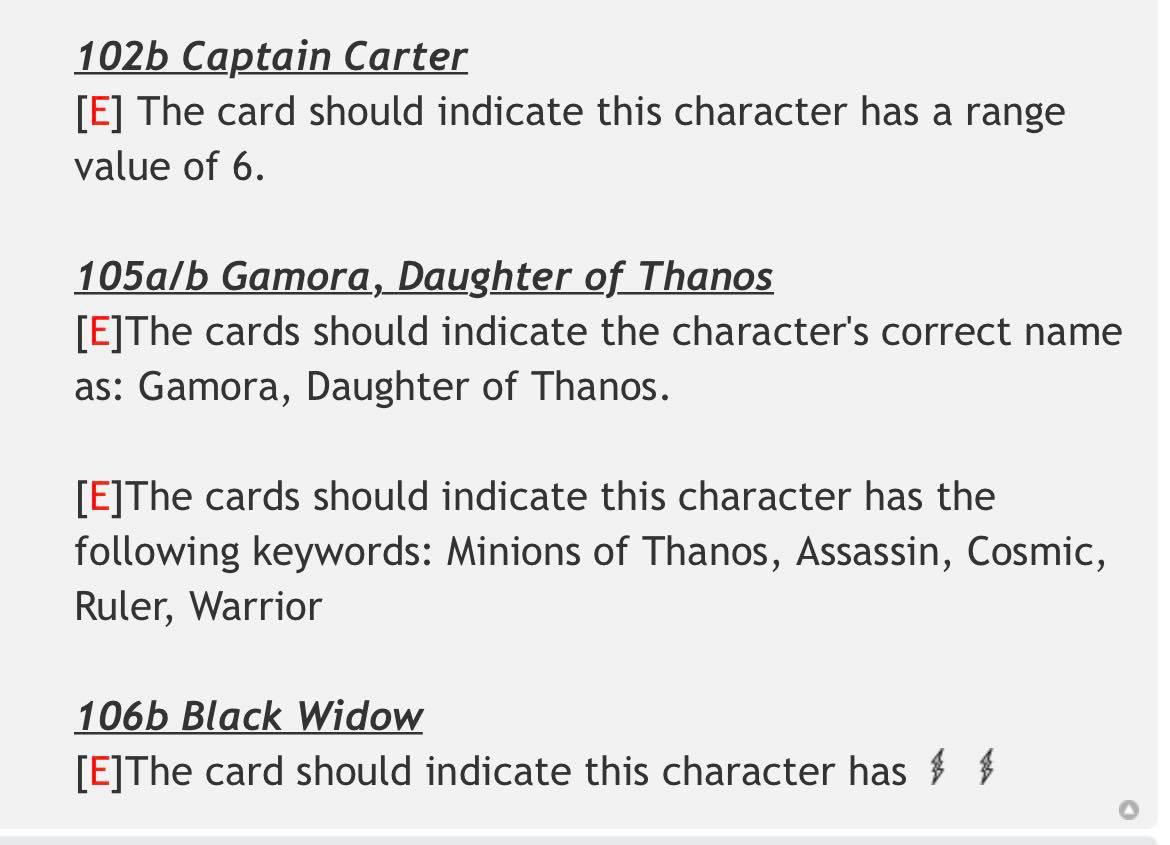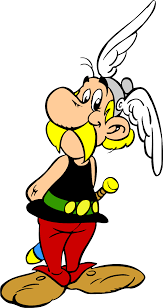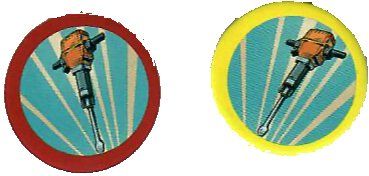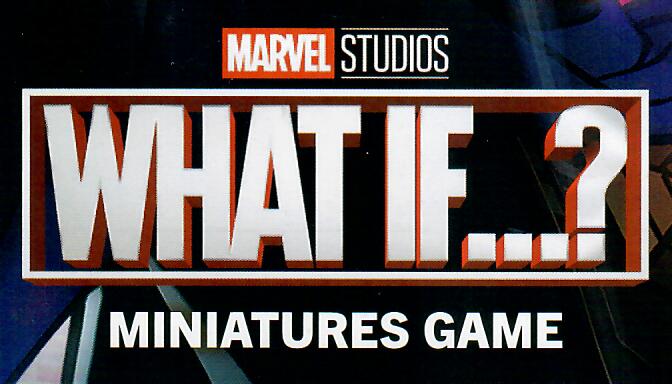
What If WizKids
Made a Good Boxed Set?
by Jeff Polier
I almost didn’t buy Marvel HeroClix: Marvel Studios Disney Plus Miniatures Game1. The last several boxed sets have had mediocre figures and multiple quality problems that should have been caught before production. That already made me wary of buying this starter. Additionally—no pun intended—the price has increased to nearly 80 dollars. Could the purchase really be worth it? I decided to find out so I bought it anyway and played it with my nineteen year old, Alex.
The What If Starter includes ten figures with two point values to play at, two cards for each the figures, six double-sided map tiles that can form two standard size HeroClix maps, a HeroClix Core Rules 2022 book, 11 cards that make up the playable Scenario, Scenario tokens, two new-for-this-set Powers and Abilities Cards, and the usual action tokens, objects, terrain markers, and dice. As has become standard, the terrain markers are round instead of square and the object tokens are small and double-sided with a light object on one side and heavy on the other. Someone on the design team wasn’t paying attention as there’s a light object that is a jackhammer and the same jackhammer art is used on a heavy object. The dice are of the same design as those in the Disney Plus Dice & Token Pack but a different color2. This is a nice change from previous starters where the dice are exactly the same.
The ten figures are the same sculpts and paint jobs as figures from the main Disney Plus set. Fortunately, though, these are all excellent sculpts. Two of the sculpts are from main set super rares and two are rares. This gives the buyer of this starter access to at least the sculpts, if not the dials, of some figures that they might not otherwise have access to. With one exception, each figure is playable at a 30 point value (clicks 1-5) and a 40 point value (clicks 7-11)3. The 30 point versions have only standard powers with most of the 40 point versions adding either a special power or trait. But how playable are they?
Captain Carter is collector’s number 102 and shares her sculpt with the 001 figure from the main set. She has five keywords: Howling Commandos, Invaders, S.H.I.E.L.D., Soldier, and Spy. Both point values have her starting off with Charge and Leadership, the higher point value’s special power “Leading By Example” giving her Charge and Flurry at the same time. They both end with Flurry and Close Combat Expert and the 40 point version has Toughness for all five clicks. Now we hit the first of many design errors I’ll be writing about in this starter. The figure and the 102a card both show a 6 range with two targets. The 102b card, though, shows only a 4 range.
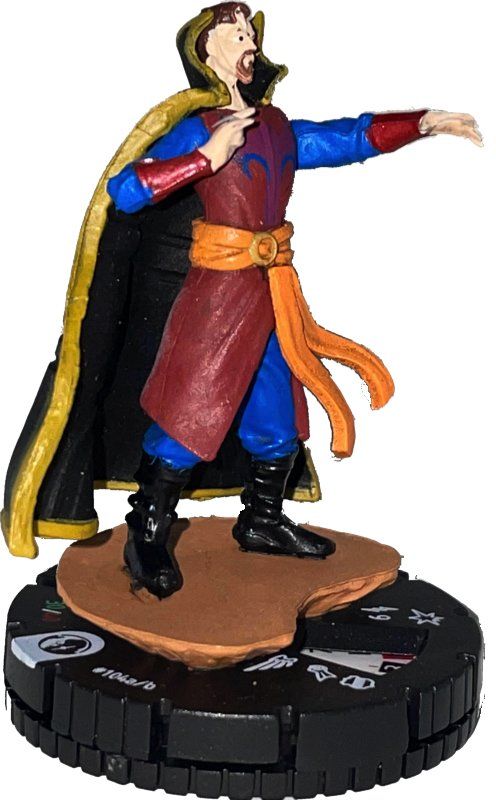
Dr. Strange Supreme is collector’s number 104 and shares his sculpt with the main set 018. He has two keywords (Mystical, Warrior) and Team Ability: Mystics. Both versions start with Super Senses and Outwit and end with Probability Control. 104b adds Running Shot on the first two clicks and a special attack power, “The Ends Justify the Means,” on the last three. This attack power reads, “When Dr. Strange Supreme makes an attack, you may choose a friendly character within range and deal them 1 unavoidable damage. If he did, Dr. Strange Supreme modifies damage +1 and may make an attack as if he occupied the square of the chosen character.” Dr. Strange Supreme has the Flight combat symbol and 6 range with a single target.
Gamora, Daughter of is collector’s number 105. Wait. “Daughter of” who or what? The cards don’t say. The base of the figure is Gamora, Daughter of Thanos. Her sculpt is shared with main set figure 010. Her keywords are—nonexistent. It’s a reasonable presumption that she’s supposed to have at least one keyword but neither card has any. Both dials start with Blades/Claws/Fangs (with the b dial having it all five clicks) and end with Exploit Weakness. 105a also starts with Flurry and ends with Combat Reflexes. 105b starts with Super Senses and her special move power, “Strike From the Shadows” which grants Charge and Stealth. She has 0 range but two targets.
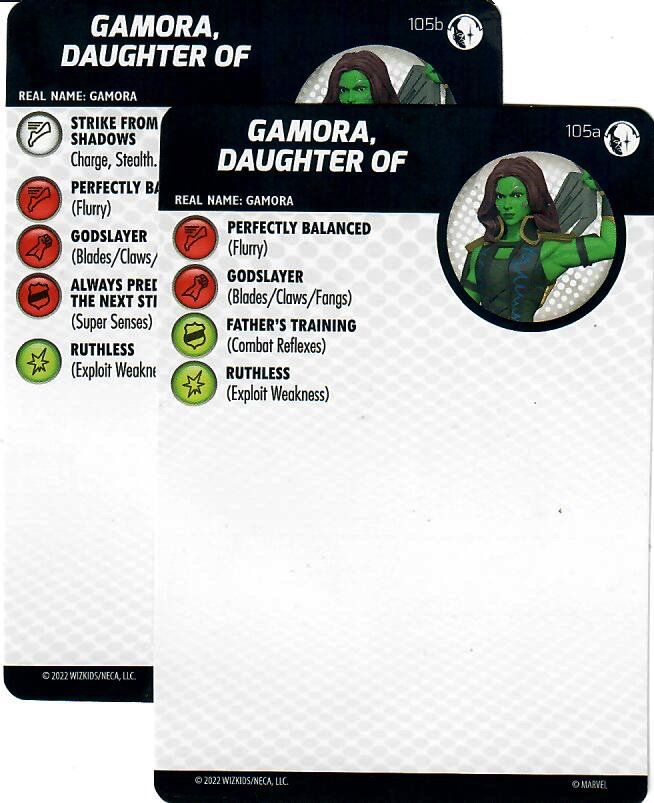
Hydra Stomper is my favorite sculpt in this starter and possibly in the entire set. The 109 starter figure shares the sculpt of the super rare 040 figure but that’s about where the similarities begin and end. Hydra Stomper has the keywords Howling Commandos, Invaders, Armor, Soldier, and Spy. Both versions have Incapacitate, Combat Reflexes, and Empower on at least part of their dials. 109b also has Charge on its first and last clicks. The Incapacitate on 109b is part of its special power, “Rounding Up the Enemies” which also grants it Giant Reach: 4. It's weird for an armored character to not have any damage reducers but, well, choices were made. He has a 4 range with three(!) targets. Unlike the 040 figure, 109 does not have the Giant damage symbol.
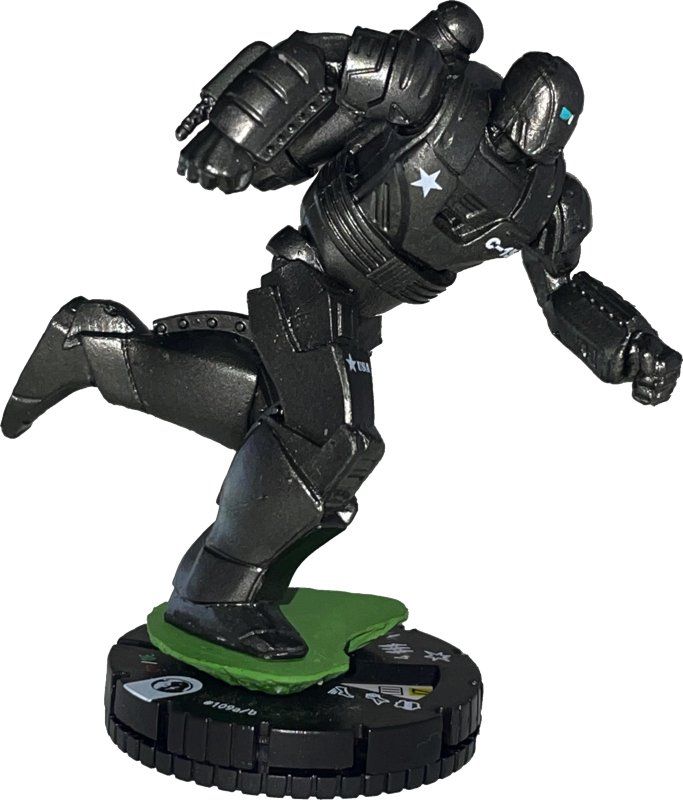
Killmonger is collector’s number 108 and shares his sculpt with figure 009. His keywords are Stark Industries, Wakanda, Soldier, Spy, and Warrior. Both dials start with Precision Strike and end with Regeneration. 108a starts with Outwit and ends with Steal Energy. 108b has Stealth on all five clicks, Outwit on his second and third clicks, and three clicks of the special power, “Stark R&D Is No Joke.” It reads “Outwit. If Killmonger occupies hindering terrain, he may use Outwit an additional time this turn.” Killmonger has a 5 range with two targets.
Party Thor is collector’s number 107 and shares his sculpt with main set 030. His keywords are Asgardian, Avengers, Celebrity, Deity, and Soldier. Both versions have Running Shot, Penetrating/Psychic Blast, Energy Shield/Deflection, and Range Combat Expert with 107b adding some Toughness. This is one of only two figures where the 40 point version does not have a trait or special power. Party Thor has the Flight combat symbol and a 5 range with two targets. If 107a and 107b have any real drawback, it’s that their speed values are so low (the only slower character in the starter being The Watcher).
Post-Apocalyptic Black Widow is collector’s number 106 and shares the sculpt of figure 017. Her keywords are Avengers, Future, Martial Artist, Soldier, Spy, and Warrior. Both versions start with Incapacitate (106b having it full dial) and Combat Reflexes and end with Stealth and Super Senses. 106b starts with two clicks of “Tactical Strike” which grants Running Shot and Stealth. The figure’s base and both cards agree that she has a 4 range but the 106b card only shows a single target with the base and 106a card showing two targets. This is presumably another design error.
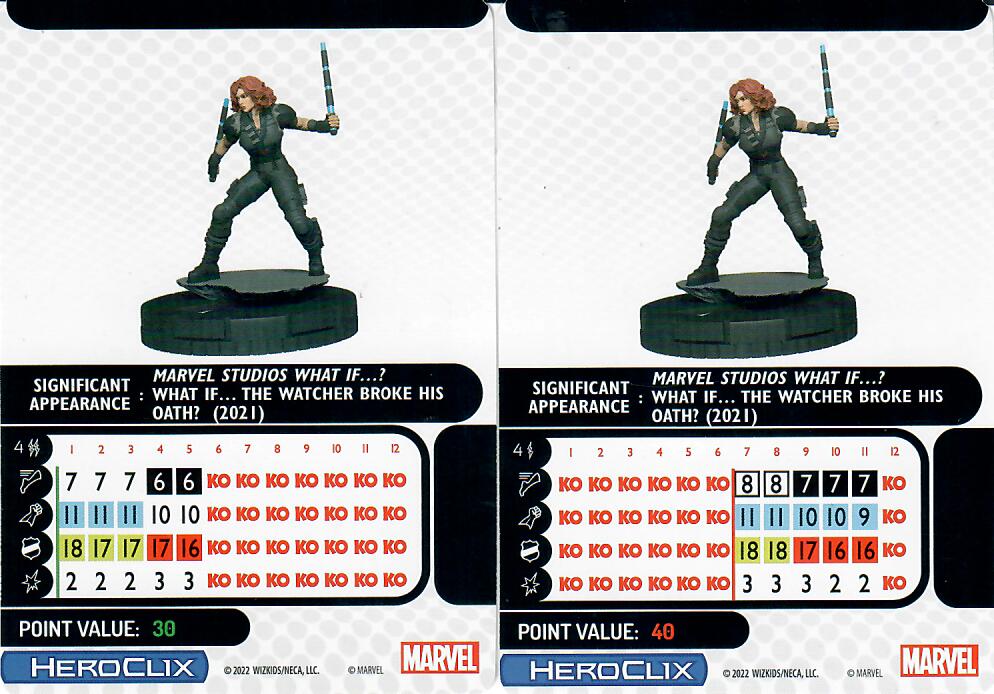
T’Challa Star-Lord is collector’s number 103 and shares his sculpt with 013 from the main set. His keywords are Ravagers, Wakanda, Pirate, Soldier, and Spy. Both versions have Running Shot, Energy Shield/Deflection, and Range Combat Expert. 103a starts with two clicks of Leadership. 103b starts with Precision Strike and ends with Hypersonic Speed. This is the other figure in this starter with no special power or trait. T’Challa Star-Lord has a 4 range with two targets.
The Watcher is collector’s number 101 and shares his sculpt with the super rare 044. The Watcher is a unique figure, has the keywords Cosmic and Herald, and Team Ability: Mystics. The Watcher is the only figure that doesn’t have five clicks of life at both the 30 and 40 point values. 101a is clicks 1-4 and 101b is clicks 6-11. Both values have clicks with Telekinesis, Defend, Outwit, and Perplex. In addition to two more clicks of life, the 101b version also has the trait “I Am…The Watcher” which reads “The Watcher’s lines of fire are never blocked. At the beginning of your turn, you may turn The Watcher’s dial to any click.” On top of that, The Watcher has an 8 range with a single target.
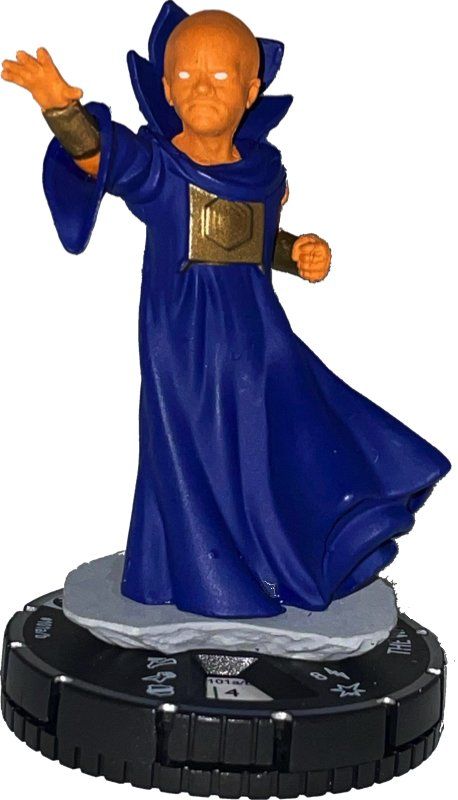
Last but not least is Zombie Captain America which is collector’s number 110 and shares his sculpt with the rare 032. His keywords are Monster, Soldier, and Warrior. Both versions have Charge followed by Flurry, Steal Energy, Regeneration, and Exploit Weakness. The Steal Energy of 110b is part of a special power, “Infection Spread.” It reads “Steal Energy. When Zombie Captain America hits with a close attack, after resolutions you may give all hit characters an action token.” Since Zombie Captain America only has one target (with a printed 3 range), he’s typically only going to have one target at a time but it’s nice that it’s worded this way to work with his Flurry if he hits a different character with each attack.
Unlike Empyre (in particular), this set has some genuinely playable figures. Given their low point costs, many of these could be used as point fillers in theme teams and not be a waste. Captain Carter is good, maybe even really good. While I prefer the Penetrating/Psychic Blast that 104a Dr. Strange Supreme has, I’d much rather pay the ten extra points two have two clicks of Running Shot and full-dial Super Senses. I really like 105b Gamora but until an errata is provided to give her keywords, she’s not likely to end up on any teams. Both versions of Hydra Stomper have triple-target Incapacitate but adding Charge and much better defense values makes 109b the obvious pick of those two. I wouldn’t play 108a Killmonger in a constructed event but I might use 108b for the possible double-Outwit. I wouldn’t call either version of Party Thor actually bad but I won’t use them in constructed because they’re slow and easy to KO. I’m also not likely to use either version of Post-Apocalyptic Black Widow although 106b’s two clicks that have Running Shot make her a better choice. Similarly, neither version of T’Challa Star-Lord is really bad but neither one is anywhere near as good as the 50 point 013 or 025 on its 40 point starting line. Zombie Captain America 110b is so far above 110a in playability that I can’t imagine ever choosing the latter and it would be good on a team with 032 Zombie Captain America.
Then there’s The Watcher. The 30 point version is barely worth mentioning. It’s OK for 30 points but the 40 point version is spectacular. This is the one item from the starter that everyone agrees is incredible. He’s almost completely a support piece with best attack value (10) being paired with his lowest damage (1) and his worst attack value (8) being paired with his best damage (2 or 3). What makes him so incredible is that his line of fire cannot be blocked and he can see for 8 squares in most circumstances. This means that, depending on his click, he can Outwit or Perplex any single character within 8 squares and he can also use Telekinesis to place objects or friendly characters as long as that object or character can “see” the destination square. Put him on a theme team and now he’s using Probability Control at a range few figures can match. If someone is buying the What If Starter just for one specific figure, this is almost assuredly that one.
The new Powers and Abilities Card (PAC) looks good. There are only minor changes for clarification over the previous PAC. Last I looked, this one isn’t available for download at HeroClix.com but that might have changed by the time you read this. I do like that it’s been compacted down from four double-sided panels to only three.
The HeroClix Core Rules 2022 is 16 pages including both covers4. It’s full color and uses some great illustrations. Wow, but there are a lot of errors that should have been caught.
Right on page 1, the front cover, we have a couple of errors. The Components List includes “8 Scenario Cards” and “Scenario Bystander Tokens.” There are 11 Scenario Cards in this starter. There are no Bystander Tokens. There are a couple of special tokens for the Scenario (“Reset”) that aren’t objects or bystanders.
Page 2: “A Quick Reference of Powers and Abilities is on the back page of this rulebook.” It’s the last two pages, 15 and 16.
On page 3, the example figure base shown is Captain Carter which would be great except that one of the spaces labeled on the base is “Team Symbol” and she doesn’t have one. Either Dr. Strange Supreme or The Watcher should have been used as an example instead. Also on page 3 is the text, “You’ll notice that her Standard Powers have changed Powers have changed.” Read that again carefully if you missed what’s wrong the first time through.
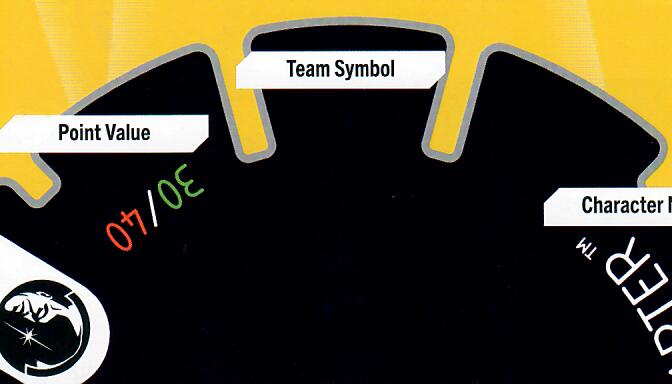
On page 4, the Setup says “Choose a scenario from the included scenario cards.” While it’s possible to just grab a scenario card and play it, the scenario is designed to start at a certain point and the cards played in order.
I’m going to compliment page 6, the page that gives background on each character. The descriptions are simple but to the point and accurate. I also like that each has a sentence or two describing how they work as a HeroClix character. It’s not without a mistake, though, with one sentence beginning “BU in this universe…” when it should be “But in this universe…”
Page 7 is why it’s important to read this rule book before playing the Scenario. “Phase 2: Action Phase. In this phase, you may take up to three actions and any number of different free actions with your characters.” Since the Scenario cards never call for teams of even 200 points, an experienced HeroClix player might presume there’s only one or two actions (depending on build total of the Scenario and/or the presence of Leadership) but this tells us otherwise.
Page 9 has something not so much wrong as just odd. In an illustration for line of fire, squares representing blocking terrain are grey. Why not use brown, the actual color of blocking terrain? Beats me.
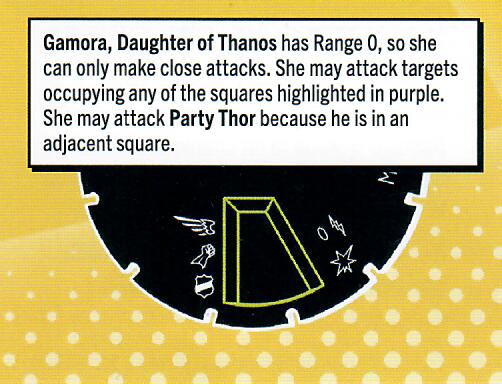
On page 10: “Targets of a Close attack must be adjacent to the attacking character; targets of a Range attack must be within range and line of fire of the attacking character.” There’s a figure in this starter, 109b Hydra Stomper, with Giant Reach so he doesn’t need to be adjacent for a Close attack.
Page 11: “All hits that have doubles cause knockback, so you may push the dummy up to 3 squares away from Captain Carter.” While the idea of knockback is that the target is being pushed away, the actual work that should be consistently used is “place.”
Page 12 describes what different colored borders mean but not purple or yellow. Experienced players of course know that purple bordered areas are the starting areas but that isn’t explained in this book that’s supposed to be for new players. Yellow borders, again as experienced players know, differentiates indoor terrain from outdoor terrain on maps that have both. Map tiles included in the What If Starter do have yellow borders. Yes, the PAC lists both but this is information that should be in the rule book for new players. Page 12 does describe elevated terrain which is a good thing—except that there isn’t any elevated terrain on the maps in this starter. Page 12 also has the word “example” misspelled as “exmaple.”5
Page 13 has the word “when” misspelled as “whten.”6
Page 14: “None of the characters contained in this box are Prime or Unique.” Except 110a/b The Watcher is unique so the box set does have one. “Every character has one or more keywords…” Except 105a/b Gamora, Daughter of nothing who should have keywords but doesn’t.
Page 15 and 16. Overall, I still like the idea of the Condensed PAC for new players. It’s far less intimidating than the full PAC but it also has errors. Really, really bad errors. “The standard powers and other abilities listed on this page can be an easy reference just like the Powers and Abilities Card, except it only includes powers and abilities used on the ‘a’ version of character cards in this set.” This is inaccurate because it includes powers (Hypersonic Speed, Toughness) and an ability (Giant Reach) that are only on the “b” dials. The Charge power doesn’t have the green circle with an x in it next to the description. The description for Flight is right off of the full PAC which doesn’t help for the Condensed PAC because new players won’t know what the symbols for Improved Movement, Elevated, Outdoor Blocking, Move Through or the symbol for Passenger will mean without referencing the regular PAC.7
Page 16 specifically: The description given for Combat Reflexes is actually what Energy Shield/Deflection does. The description for Energy Shield/Deflection is for Barrier, a power that isn’t even in this starter. The description for Phasing/Teleport8 is between Defend and Super Senses but a) as written, it looks like it’s part of Defend and b) no character in this set has Phasing/Teleport. The description given to Close Combat Expert is the description for Shape Change instead (another power not in this set).

If you’ve read anything I’ve written about the recent starter sets, you already know that I’m not fond of the map tiles instead of the usual paper maps. They’re heavy, fairly easy to disturb, and unless you keep them someplace very dry then they’re going to warp.
The two maps these double-sided tiles combine to make are without a doubt the worst maps that WizKids has produced in the past 15 years. The art is cartoonish, harkening back to the days of Infinity Challenge and Hypertime. That is NOT a compliment. The two sides, “Downtown” Indoor Outdoor (tiles 1A-6A) and “Apocalyptic Avenue” Outdoor (tiles 1B-6B) are the same location but either at a different time or in different dimensions. That, in itself, is a neat idea. It’s the execution that is completely lacking. They’re just plain ugly, not even remotely up to the quality of art that WizKids has used on their maps since shortly after the game began. There are other problems that I’ll bring up when discussing the Scenario Cards. I do applaud the idea that the Scenarios use just select tiles instead of full maps but that’s also part of the problems I’ll be writing about later.
There are nine tokens for use with the Scenario, one for each of the six Infinity Stones, a Reset Token, an Obelisk Yes token, and an Obelisk No token. My starter came with two complete sets which I guess was an error because there’s no need for two of each.
The Obelisk tokens are the same on one side but say Yes or No on the other. These are used as part of the Scenarios. My comments on them related more to the Scenario instructions than the tokens themselves so I’ll hold off for now.
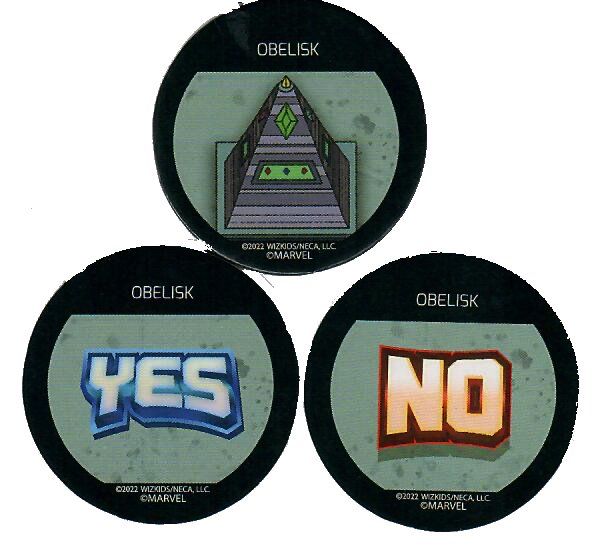
The Reset Token is sometimes given to a player at the end of a Scenario to use in the following Scenario. The text on the back of the token reads, “At the beginning of your turn, place this token in the same squares as a friendly character, remove any action assigned to that character, and remove this token from the game.” There’s so much wrong with this. To start with, there’s no reason to place the Reset Token in the square of the character you’re using it with since you’re right away going to remove the token from the game. Second, none of the characters using this scenario have multi-square bases so the token should be placed in the character’s square (singular) and not squares (plural). Third is the text “…remove any action assigned to that character...”. Since this is done at the beginning of the turn before a character could have been given an action, it’s safe to presume that we’re supposed to remove at least one action
token. Given how it’s worded, it seems like it should say “…remove any action tokens…” and that’s how Alex and I played it.
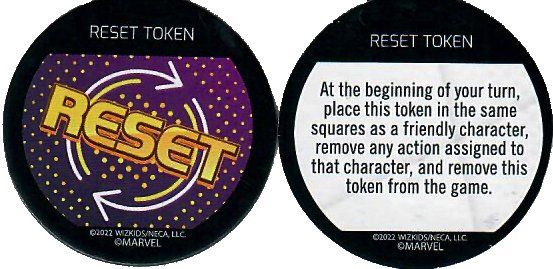
The Infinity Stone tokens are all considered Equipment and most grant a standard power. All of them have “Unequip: Drop.” Each that gives a standard power contains the text, “…after resolutions roll a d6. [1]-[2]: Give this character an action token.” That presumably means an additional action token and that’s how Alex and I used them. The sixth gem, the Space Stone, instead grants “When this character is given a MOVE action, modify speed +3.” Since many of the scenarios are only played on one or two map tiles (so either 8 by 8 squares or 8 by 16 squares), we didn’t find this a useful strone. If it said, “When this character moves, modify speed +3” then it would be far better since that would work with Charge, Running Shot, or Hypersonic Speed.
The problem that is part of all six Infinity Stones is that they are Equipment but don’t have anything to describe if, when unequipped, they are light or heavy objects. For our playing at home, I ruled that they’re immobile; they can’t be moved or placed and, by the regular rules of using Equipment, a character has to be in the same square as the Equipment to equip it.
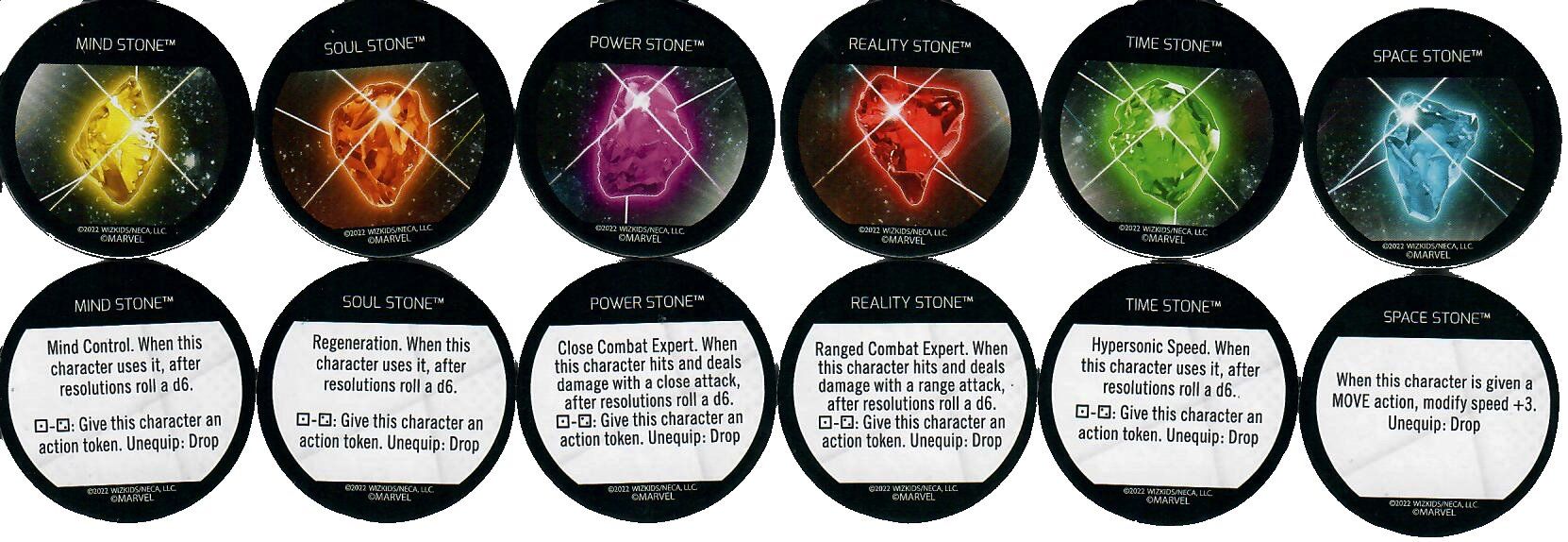
Now we come to the Scenario. As previously noted, there are 11 Scenario Cards. The double-sided cards are numbered like pages, 1-22. The overall story in the cards is that Dr. Strange Supreme and his heroes (perhaps a questionable description on my part) trying to obtain the Infinity Stones and The Watcher and his heroes trying to stop them. I really love the idea of this story. Although there are problems with playing some of the Scenario Cards, the overall idea is great.
Card one (pages 1 and 2, if you will) it all set up. Side 1 describes that “When a scenario tells you to ‘Hide an (Infinity) Stone’ as part of the setup, you would first shuffle the 2 Obelisk tokens facedown and place one in each obelisk square on the map.” The only minor problem with this is in general is that the obelisk squares aren’t described but do at least match the art on the Obelisk tokens. Next is the instruction “Starting areas for scenarios are in the solid purple lines with purple shading (generally the furthest away from the opponent).” Finally! Some kind of description for starting areas! Just not if you’re using the full sized maps. Thirdly, there are three traits that all characters have in relation to the Infinity Stones. Only the second of the three has any wording that’s questionable. “CLOSE: When this character destroys an Obelisk token with ‘YES,’ equip this character with the corresponding Infinity Stone.” Normally, destroying an object requires a CLOSE Destroy action with a character able to do 3 damage. Given how this is worded, we decided that only a CLOSE action (not CLOSE Destroy) would be needed. We also decided that since we were destroying each Obelisk to put a rubble terrain marker in the space after. Side 2 of the card just sets up the story.
The rest of the Scenario Cards follow a pattern. The front, odd-numbered side proceeds the story a little more, instructs you which map tile or tiles to use, and which characters at which point values for each side to use plus sometimes further special instructions. The even-numbered side gives the win conditions for both players. There are instructions for both teams as to how to proceed if they win that Scenario.
Scenario A: Cafe Clash has no problems with the actual Scenario Card. It’s simple and straightforward. The instructions on how to proceed are the same no matter which side wins. The only problem is that the map tile is ridiculous. It’s an indoor tile (which, I’ll remind you, is something that new players wouldn’t know) and the counters in this cafe are all blocking terrain. Yep. Counters that go to the ceiling. Sigh.
Scenario B: The Obelisk is played regardless of who won Scenario A. This one uses two map tiles together, 1A and 2A with the team that won the previous Scenario being assigned to the starting area on tile 2A. Card 5 says, “Hide the Space Stone” so the Obelisk tokens are randomly put onto the two obelisk squares. No matter which team has possession of the Space Stone when one of the win conditions is met, the winning team takes the Space Stone to assign to one of their characters next time.
This is where branching of the Scenarios happens, with Scenario C being next if The Watcher’s team wins and Scenario D if Dr. Strange Supreme’s team wins. For this review, I’m going to just follow the cards in order (B then C then D etc.).
Scenario C: The Power Stone! is played only on tile 3A. The Watcher’s player chooses their starting area and Dr. Strange Supreme’s player goes first. The problematic instruction is “Hide the Power Stone.” The reason this is a problem is that tile 3A doesn’t have any obelisk squares to place the Obelisk tokens onto. One of the win conditions requires already having the Power Stone and then being in the other obelisk square. Since that’s not actually possible, Alex and I decided that the only win condition was the other one: “KO all opposing characters.” If Dr. Strange Supreme’s team wins then play goes to Scenario E and Scenario F is used if The Watcher’s team won. Something else that should have been caught is the instruction that “The Watcher’s player uses The Watch, Hydra Stomper, and Killmonger at 30 points each.” Clearly that should have been “The Watcher,” not “The Watch.”
Scenario D: The Time Stone! is played on map tile 1B with Dr. Strange Supreme’s player choosing their starting area and The Watcher’s player going first. Very similar to Scenario C, there are no obelisk squares on this tile which makes one of the win conditions impossible to achieve. A win for The Watcher’s team means proceeding to Scenario E. A win for Dr. Strange Supreme’s team means jumping ahead to Scenario G.
Scenario E: The Soul Stone! is played on tiles 3B and 6B. There’s no problem with this Scenario since each of the two tiles has an obelisk square. Both win conditions are viable. If The Watcher’s team wins then play goes to Scenario H and otherwise play goes to Scenario I.
Scenario F: The Mind Stone from Earth-2192! is played on tile 4A. This Scenario was also playable as stated with both win conditions being possible. If Dr. Strange Supreme’s team wins, Scenario H is played next. If The Watcher’s team wins then the campaign is over and they’ve won the story. The problem on this card should have been caught in editing: “…placed in an adjacent square. And the character who…” This should have read, “…placed in an adjacent square and the character who…” The other problem with this Scenario is that each team has four characters but each starting area only has 3 squares. Not a problem for experienced players but it could be confusing for new people.
Scenario G: The Mind Stone from Earth-2149! is played on map 4B. The Watcher’s team has a distinct advantage in this Scenario. Both obelisk squares are behind blocking (either full squares or walls). The Watcher’s team for the Scenario includes Party Thor who has the Flight ability. Dr. Strange Supreme’s team doesn’t have any flyers. Other than that, this is another Scenario playable as written. If The Watcher’s team wins, play goes to Scenario I. The campaign is over if Dr. Strange Supreme’s team wins. Like Scenario F, the starting areas aren’t big enough for the sizes of the teams.
Scenario H: A Desperate Ploy is played on tiles 1B, 2B, 4B, and 5B. Dr. Strange Supreme’s team starts in either starting area on tile 1B. The Watcher’s team “…set up in the starting area of tile 5B”—or they would if there was a starting area on 5B. The win conditions for this Scenario are specific to each team. There are only two win conditions listed on side 18 of the card but there are four possible outcomes. The Watcher wins the Scenario—and the campaign—if The Watcher himself KO’s two opposing characters. Dr. Strange Supreme wins if he manages to cast a spell as described on side 17 of the card and this also ends the campaign. Not listed as win conditions but still possible are The Watcher’s team winning by KOing all opposing characters, in which case the campaign also ends. If Dr. Strange Supreme’s team wins by KOing all opposing characters, play proceeds to Scenario J. These other two win conditions should have been clarified on the card. The name of the spell that Dr. Strange Supreme is trying to use, Calx Orbis, is written twice in a row and the second one seems like an accident.
Scenario I: Stop Stephen Strange! is played on tiles 2B, 3B, 5B, and 6B. Dr. Strange Supreme’s team starts on 2B and The Watcher’s team starts on 6B. This Scenario does have only one way for each team to win. If Dr. Strange Supreme’s team wins, play proceeds to Scenario J. If The Watcher’s team wins then they’ve won the campaign.
Scenario J: The Reality Stone! is played starting on the full “Downtown” map. There are no instructions for new players on how the starting areas work for this. The Special Rules9 for this scenario are “At the end of your turn, roll a d6. That map tile is flipped over. Any game elements occupying that map tile get placed in a correlating square (or the closest square if it can’t be placed on the same one).” This is a huge problem because the tiles don’t match when you flip them over. For example, tile 4A (containing squares I1 through P8) when flipped over becomes tile 1B (squares A1 through H8). It doesn’t work unless you flip over a set of tiles at a time: 1 & 4, 2 & 5, and 3 & 6.
Did you notice anything missing in all of those Scenarios? The Reality Stone token is never used! Since the special tokens for this Scenario aren’t usable outside of it, there’s no reason for the Reality Stone token to even exist.
After examining the What If Starter and writing over 5000 words on the subject, do I think it’s worth buying? Probably not. Despite a few errors that erratas could fix, the figures range from good to great and would have made a spectacular Fast Forces for 25 or even as much as 35 dollars. Nothing else in this box set brings the value up to 80 dollars. The maps are bad whether you like the tiles over paper maps or not. If you’re an experienced player and really have the extra money to spend, I guess go ahead10 but I wouldn’t recommend doing so unless you’re receiving a very nice discount.
For a new player, this starter is a hard “NO” unless you have money to burn and an experienced player to help you learn to play. Even then, a potential player would be better off buying a few boosters and having that experienced player teach them to play using those.
While this set is much better than the Empyre Starter when it comes to figures that will be played in constructed games, it is still an utter failure as something to entice people to play HeroClix. The lack of quality in the design of various parts of the What If Starter is appalling and unprofessional. A product with this many errors should not have been released, especially as something to introduce new people to the game. It was bad enough when these boxed sets, “Miniatures Games,” were 60 dollars each. At 80 dollars, it’s a travesty.
When the next starter comes out, I will not be buying it at retail. I’ll be glad to review someone else’s copy or buy it at a steep discount but WizKids is not addressing the design problems that have been in each of these boxed sets since they started doing them with Cosmic Clash.
As someone who wants the game to continue and the player base to grow, I am deeply disappointed that WizKids continues to not put their best foot forward11. Let’s hope they spend more time preparing the next box set, making it as perfect as possible, before sending the files off to be produced.
1 That’s the name given in the included rule book. Everything else on or in the box says Marvel Studios What If Miniatures Game. For simplicity’s sake, I’m going to usually refer to it as the What If Starter or just the starter.
2 The dice in this starter are red. The other dice are blue.
3 The 30 point dial uses the a card and the 40 point uses the b card. For example, Captain Carter’s cards are 102a and 102b.
4 Both covers, outside and in, contain part of the rules which is why I include them in the page count.
5 They must not have had spell check turned on because exmaple isn’t even a word.
6 Ditto. Spell check is your friend, WizKids. Don’t be afraid of it.
7 That also applies to the symbols for Improved Targeting: Hindering in the Giant Reach keyphrase description.
8 “MOVE: [Improved Movement: Elevated, Blocking, Characters]. Move.”
9 It should be Special Rule since there’s only one.
10 After all, I did.
11 I really, honestly hope this isn’t already their best foot being put forward!
6 June 2022
WizKids, HeroClix, Combat Dial, and related market and logos are Trademarks of WizKids. Copyright 2022 WizKids/NECA LLC
Marvel, What If, and all characters mentioned in this editorial (except Asterix!) are the property of Disney.
This article is copyright 2022 by Jeff Alan Polier. You are welcome to share the link to this article but please do not copy it without permission.
UPDATE 8 June 2022: WizKids has officially posted errata for the four character cards that had errors. This is good but doesn't erase the fact that these errors should have been seen and taken care of before the files for the cards went to the printer.
